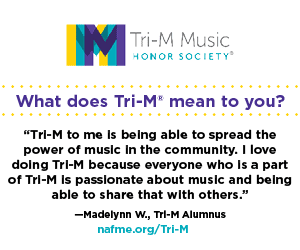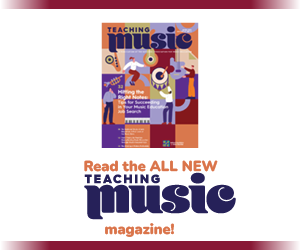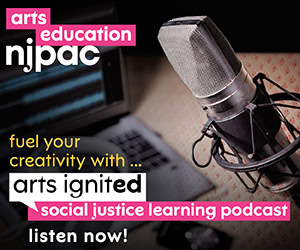/ News Posts / Songwriting for Music Educators
Songwriting for Music Educators
Ways to Introduce Songwriting to Students at All Levels
By NAfME Member Kelsey Giotta
Kelsey Giotta presented on “Songwriting for Music Educators” during the NAfME 2021 PreK–12 Learning Collaborative in February 2021.
Like me, you might initially find the thought of teaching songwriting almost laughable. My primary instrument is the French horn, and it is not often that you run into a French horn playing singer-songwriter at your local coffee shop. In addition to my own lack of confidence, I questioned whether songwriting was a good fit for my students. Since I first introduced songwriting to my middle school classes five years ago, it has become one of my and my students’ favorite and most enjoyable units of the school year. Songwriting allows students the opportunity to be individually creative and expressive through music and is an excellent way for music educators to foster a more student-centered classroom environment. As the teacher, it can be liberating to shift from leading or directing the class to facilitating a creative process. In this post, I will outline some ways to introduce songwriting to students at all levels.
Songwriting can be a valuable activity within a variety of music education contexts and settings. I teach a class for seventh and eighth graders called “Creative Musicianship” that is a music elective based around learning to play the ukulele. Each spring we complete an approximately six-week unit on songwriting. Songwriting could occur within the context of a general music course; as an elective in and of itself; as a part of a guitar, keyboard, or ukulele class; or as an opportunity for students in large ensembles to be expressive and creative. With age-appropriate modifications, individuals from preschool through adult can participate in the process of writing a song.
Start with Song Form
Teaching song form first can feel more comfortable for music educators and students alike. Whereas the abstract directive, “write a song,” can be overwhelming and intimidating, learning about the form of popular music is more structured and concrete. I first introduce the following vocabulary terms: verse, chorus, introduction, bridge, and outro. Students can apply these terms by labeling the different sections of lead sheets to songs that are both familiar and unfamiliar to them. Once students are comfortable doing this, we move onto aurally identifying the parts of a song. Finally, I have students work in groups to identify and discuss the emotions they think a song communicates.
Writing Lyrics
In my experience, students generally have an easier time writing lyrics than selecting chords or coming up with a melody. Writing lyrics may be similar to work students have done before in their language arts classes writing poetry. For the first set of lyrics that students write in my class, I give them a checklist of requirements as shown here:
- There are at least two verses
- There is a chorus
- The two verses are of the same length
- The two verses are related in some way
- There is a theme that unites the chorus and the verses
I give points for completion of each checklist item and offer students individual feedback, rather than grading in an evaluative way. While some students may be eager to write a song about a topic of their own choosing, others may struggle to come up with an initial idea. It can be helpful to set a topic for the entire class to write about. Silly songs work particularly well for students’ first song. Other topic ideas might include school, activities, hobbies, various seasons, family, friends, or travel. One of my favorite topics is to have students write a “love” song, but I encourage them that it doesn’t have to be romantic and could express their feelings for anything or anyone. I have had students write love songs to bacon, ballet shoes, and their dog in the past!
Before giving students time to work independently, it can be helpful to create and work on a group or class song together. The teacher facilitates the group writing lyrics together and this demonstrates the creative process to students who might be unsure where to start. There are a variety of song lyric generators and “mad lib” song builders available online that can be a fun tool for supporting this process.
Selecting Chords
We then move from the lyrics to selecting chords and creating chord progressions. Keep in mind, songwriting is not a linear process. Just because we move onto selecting chords does not mean that the lyrics are unchangeable. I suggest that music educators keep chord progressions very simple and easy as students get started with songwriting. The majority of popular music only uses I, IV, V7, and vi. Younger students might be adequately challenged to use only one or two chords. For their first song, I encourage students to come up with one chord progression that can be repeated for the chorus and a slightly different one that can be repeated for the different verses. We also only use the chords students find the easiest and most comfortable to play. For ukulele, that means C, F, G7, and Am. If we are writing with only two chords, F and C7 might be even simpler on ukulele. There are also various and apps and websites like Autochords and Ukulele Go! that can help jumpstart ideas for students.
Melody
The melody is oftentimes the most challenging part of the song for students to write. I suggest students take their chord progressions and improvise by either humming or lightly singing and/or chanting their lyrics with the chord progression. This often results in both the lyrics and chord progressions being modified, but that’s an important part of the cyclical creative process. Some students find it helpful to have another student or the teacher play the chords while they improvise a melody or even just listen while considering the lyrics. On YouTube, there are excellent videos available from Berklee Online and Dylan Laine explaining the songwriting process. These videos can be a great tool for students and might explain the songwriting process in a different way students understand better.

Feedback and Assessment
Throughout the songwriting process I try to keep feedback positive and encouraging and limit assessment to completion checks. It can feel nearly impossible to evaluate a creative endeavor like songwriting. By creating a safe classroom environment and modeling how to give appropriate constructive feedback, students can eventually workshop each other’s songs. With guidance, students’ peers can become their best critics and encouragers.
Go for It!
As with many creative activities, you may be surprised by students’ success and engagement with songwriting. It can feel intimidating to teach or facilitate something you are uncomfortable or inexperienced with, but admitting this vulnerability to students can help them to feel more confident in trying something new as well. There’s no reason you can’t sit down and write a song alongside your students! Songwriting naturally brings more open-endedness and less structure to the music classroom, and this can be overwhelming or even scary. I challenge you to push yourself outside of your comfort zone and perhaps be surprised by what a rewarding and refreshing process songwriting can be, both for yourself and your students.
About the author:
 NAfME member Kelsey Kordella Giotta is in her eleventh year of teaching in Plain Local Schools in Canton, Ohio. She teaches middle school and high school band as well as Creative Musicianship, a course based around creative musical explorations through ukulele performance. She holds a bachelor of music in music education from the College-Conservatory of Music at the University of Cincinnati, as well as a master of arts in music education from Case Western Reserve University. She has presented on various topics in music education at a variety of local, state, national, and international conferences. Giotta has also served as a leader and chairperson for the Ohio Music Education Association in various capacities. She was a finalist for the Canton Symphony Orchestra Music Educator of the Year award in 2018 and has been named a “Top 25” educator in Plain Local Schools several times.
NAfME member Kelsey Kordella Giotta is in her eleventh year of teaching in Plain Local Schools in Canton, Ohio. She teaches middle school and high school band as well as Creative Musicianship, a course based around creative musical explorations through ukulele performance. She holds a bachelor of music in music education from the College-Conservatory of Music at the University of Cincinnati, as well as a master of arts in music education from Case Western Reserve University. She has presented on various topics in music education at a variety of local, state, national, and international conferences. Giotta has also served as a leader and chairperson for the Ohio Music Education Association in various capacities. She was a finalist for the Canton Symphony Orchestra Music Educator of the Year award in 2018 and has been named a “Top 25” educator in Plain Local Schools several times.
Did this blog spur new ideas for your music program? Share them on Amplify! Interested in reprinting this article? Please review the reprint guidelines.
The National Association for Music Education (NAfME) provides a number of forums for the sharing of information and opinion, including blogs and postings on our website, articles and columns in our magazines and journals, and postings to our Amplify member portal. Unless specifically noted, the views expressed in these media do not necessarily represent the policy or views of the Association, its officers, or its employees.
August 24, 2021. © National Association for Music Education (NAfME.org)
Published Date
August 24, 2021
Category
- Innovation
Copyright
August 24, 2021. © National Association for Music Education (NAfME.org)






